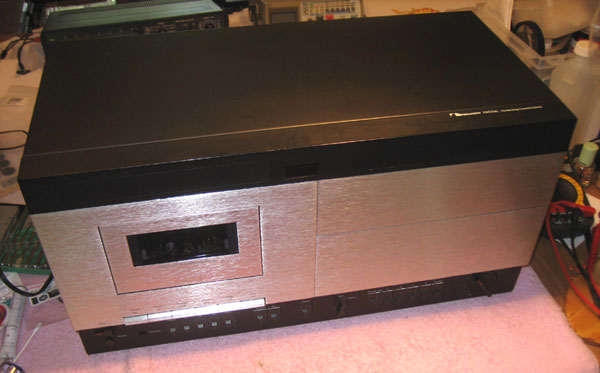June 9, 2008
As Luck Would Have It
I was at Goodwill scrounging for LPs when I saw
something unusual -- not an unusual occurrence at Goodwill. Off to my left was a
silver-and-black rectangular box that, on quick glance, looked like a cross between a
stainless-steel microwave and a toaster oven but not really like either one. It was big
and eye-catching sitting there among the old rotary telephones and beat-up fax machines.
Closer inspection revealed its identity -- a
Nakamichi 700ZXL cassette deck. On top was taped the user manual and an odd-looking
peripheral: a Nakamichi NR-100 outboard Dolby C processor. The entire conglomeration was
priced at $15, but it was half-price day, so $7.50 would take it home. "What is that?"
a guy standing next to me asked as I inspected the deck. "A Nakamichi tape
deck," I answered, pulling it from the shelf. His interest increased my interest.

As soon as I got it home, I plugged it in, hoping
for perfect working order but closely watching for smoke. The lights came on and there
were no untoward smells. So far so good. I dug through one of the closets for a cassette
tape. The reels spun and the tape played!
The 700ZXL was made in the early 1980s. It was
considered a less costly and more compact version of the enormous, top-of-the-line
1000ZXL, many of whose features it shares. The 700ZXL cost $3000 when new -- far beyond my
means in those days. This would translate to $7000 today. I could easily understand the
high cost once I removed the metal outer cover. The large chassis was packed with
circuit boards for the deck's many features, including auto calibration and battery-backup
memory. But all was not in perfect working order. Some of the display areas didn't
illuminate, and there appeared to be a problem with the meters. Bigger still was an issue
with recording, which caused the left channel to hiccup when using that outboard Dolby
processor.
Nakamichi cassette decks were once the
audio status symbol. If you owned one, you were known to have good taste and the money to
exercise it. Nakamichi decks remain popular today, even though their maker abandoned them
over a decade ago, ceasing manufacture and no longer stocking parts. But others have
filled in. "Business is overwhelming," Jeff Galin, the owner of Electronic
Service Labs, told me. Known by its initials, ESL services Nakamichi cassette decks of all
but the very oldest vintages. If you send a deck to Jeff today, you likely won't get it
back for more than six months -- his backlog is immense. Because of their many moving
parts, cassette decks are prone to breaking down, but one of the prevalent problems with
Nakamichi decks is due to the capacitors the company used for many years, which go bad
over time. This leads to what Nakamichi aficionados call "orange cap disease" in
honor of the color of those bum caps. Cassette decks also need periodic alignment in order
to continue making the best-sounding tapes.
Jeff Galin and his staff are renowned among
Nakamichi enthusiasts, many of whom have collections of cassette decks, for the service
and restoration work they do. But this doesn't come cheap. My 700ZXL, for instance, could
cost $2000 to bring back to working condition. For this reason, I've let a knowledgeable
person do some triage before I decide to send it in for repair -- or put it up for sale on
eBay.
I visit Goodwill every now and then, hoping to
find some other vintage audio bonbon, but I've probably used up all of my good luck by
finding a Nakamichi 700ZXL. I will give progress reports as I find out what's wrong with
this deck and how much it will cost to fix. That it's big and eye-catching is undeniable.
...Marc Mickelson
marc@soundstage.com